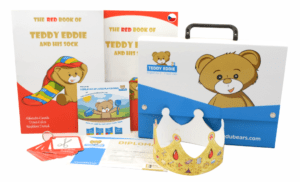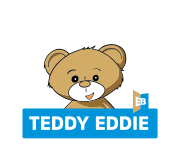Here’s our Teddy Bear known as Teddy Eddie.
Eddie is quite a playful bear and he sleeps in a smelly sock. He has already encouraged thousands of children to learn English at language schools with him.
5000 that’s the number of vocabulary items which an educated American adult uses in everyday conversation.
Teddy Eddie is a method of teaching English to children. With the Teddy Eddie method children learn their first 2,000 words and are prepared for the next, more advanced stage of learning.
Are you wondering if you should sign up your child for a Teddy Eddie course?
We do believe you should!
Teddy Eddie is:
CHILD-FRIENDLY
MULTI-LEVEL
FLEXIBLE
AMBITIOUS
PARENT-FRIENDLY
RELIABLE
CHEERFUL
LANGUAGE-RICH
NATURAL
The observations of our methodologists have shown that with Teddy Eddie, children learn up to five times more words than they do with other standard courses currently available on the market. Free conversation is possible much sooner than with other methods. Parents quickly see the effects of learning that go beyond the knowledge of vocabulary – many sentences and contexts make children learn to think in a foreign language, which in turn improves their communicative abilities.
Key features of the Teddy Eddie method:

Genuine language use
Learning a language involves so much more than memorizing a collection of single, unconnected words. In order to experience their communicative value, words need to be connected, to form meaningful phrases, sentences, utterances and texts. Prioritizing such connected language – a cornerstone of the Teddy Eddie method – establishes a firm, solid link between language learning and genuine language use.
.

More than having fun and being familiarized with a language
Teddy Eddie believes very firmly that learning English at a very young age can be made so much more than merely taking part in fun activities and being familiarized with bits of foreign language to be actually acquired and used much later. In our method, we strive towards tangible, measurable learning outcomes, which are observable here and now. To this end, we implement a number of tried and tested strategies and techniques to motivate children to use English inside and outside the classroom.
…
..…

Relevance to today’s children
Impactful course content needs to appeal to the sensitivities and inclinations of today’s children. Tailoring all the course materials to match the ever-changing expectations of its little users is an ongoing challenge for the Teddy Eddie method. This involves our unique style of audio recordings, our cartoon-style characters, and our trademark sense of humour.
About the course:
Each Book in the TEDDY EDDIE Method has been designed for 60 class meetings, lasting 35 to 45 minutes each. Classes are held twice a week.
Those selected are given comprehensive training, including selected aspects of foreign language teaching methodology, the specifics of working with preschool children, and a thorough introduction to the TEDDY EDDIE Method. They are also equipped with detailed instructions, procedures, lesson plans and supplementary materials to enrich their lessons.
Classes are regularly supervised and discussed with the Method Supervisor. Selected lessons are recorded and then viewed by the Licenser’s methodologists. These lessons are evaluated according to the TEDDY EDDIE METHOD STANDARD, not only to maintain the highest quality courses, but also to constantly develop the skills of the teachers conducting these classes.
- regular verbal reports about the progress of a the whole group and/or their own child, provided after each class
- weekly emails with information about the material covered and suggestions about how the new language can be revised with a their child at home
- open classes at the end of each semester
- written end-of-term reports about their child’s progress
Course components

Recordings
Evaluation of learning outcomes
– mastery of target vocabulary
– story comprehension
– responses to the teacher’s instructions
– answering the teacher’s questions
– participation in games and quizzes
Teddy Eddie at home
We know from personal experience that parent involvement has an immensely positive impact on learning outcomes. Teachers and Local Method Coordinators will be happy to help you, offering support and advice.
Current research shows that children achieve better results if they maintain contact with the language at home as well as in class.
To facilitate this home-school link, the Teddy Eddie package includes a set of recordings which a child should listen to at home several times a week. All that a parent needs to do is to press the PLAY button on on the application.
It is enough to play recordings in the background while the child engages in other activities. It is this additional, systematic exposure to the target language that yields beneficial effects over time.
The Parents’ Guide includes all the texts which are used in class (stories, songs, and rhymes) as well as the vocabulary from each chapter together with the translation.
Optionally, parents can take advantage of extra ideas for using the student’s book, course recordings and a secret booklet to play with the child and thus provide additional language practice.
In our experience, every form of parental involvement in the learning process has a hugely positive impact on learning outcomes. Teachers and Programme supervisors will offer plenty of assistance, provide support and give specific suggestions as appropriate.

